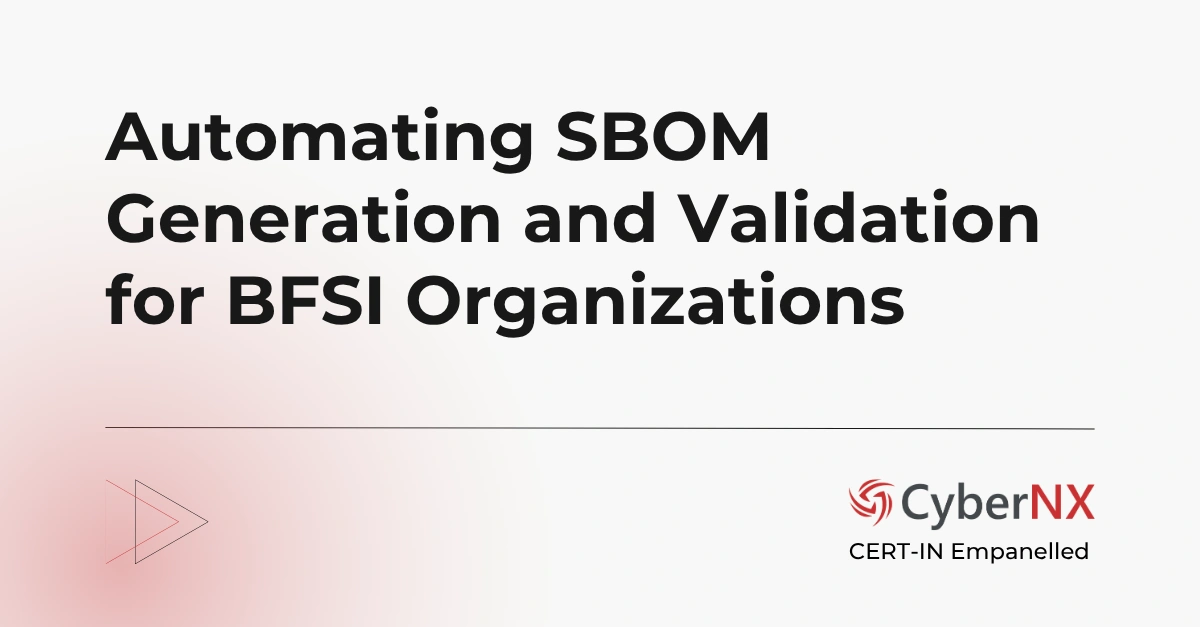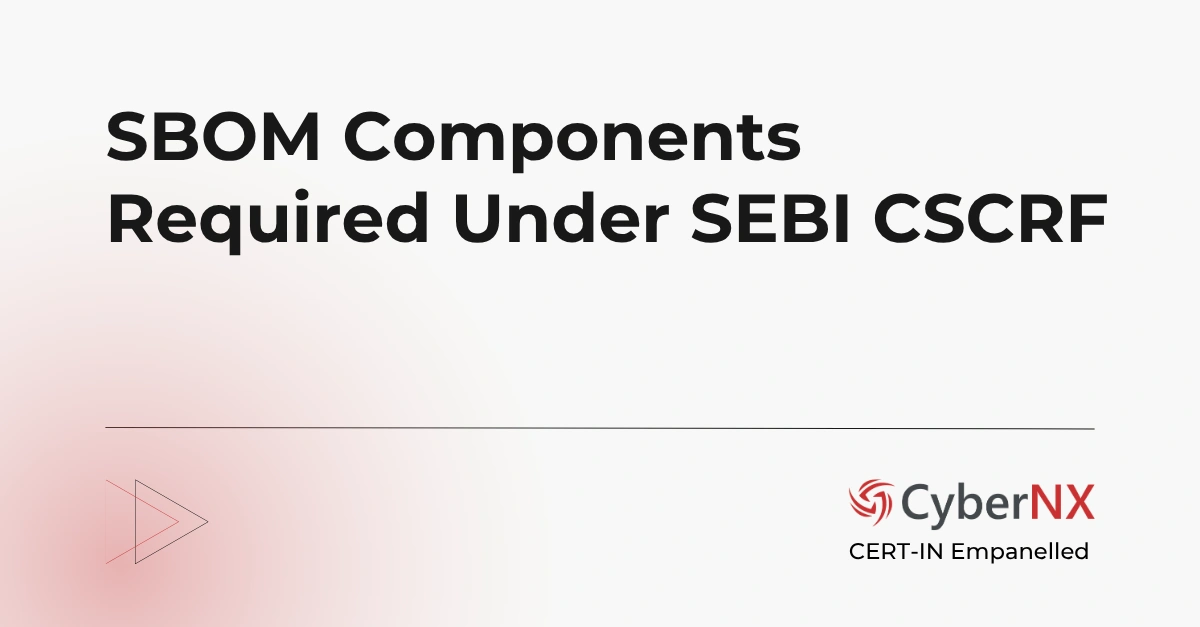India has taken a significant step to boost transparency and resilience in its software supply chain. With CERT-In), SEBI and RBI formalising expectations around Software Bill of Materials (SBOM) and Cryptographic Bill of Materials (CBOM), cybersecurity becomes an important compliance domain.
For CISOs, IT heads and cyber-leaders this means moving from theory into operational must-haves. We’ve been keenly following the regulatory updates, and here’s what really works when addressing SBOM and CBOM compliance.
What is a Software Bill of Materials (SBOM)?
A Software Bill of Materials (SBOM) is a detailed inventory of all components, libraries, dependencies and modules that make up a software application. It specifies version numbers, licensing, source origins and third-party dependencies. In short, it gives visibility across your software stack.
Why SBOM is essential for modern development
Modern applications rely heavily on open-source and third-party libraries. That reliance increases the risk of introducing vulnerabilities through outdated or insecure components.
An SBOM helps teams track every component within their software, making vulnerability detection and patching faster while also supporting compliance with license terms and regulatory requirements.
What is CBOM?
A Cryptographic Bill of Materials (CBOM) is a detailed inventory that lists all cryptographic assets used within a software application or system, including algorithms, libraries, keys, and certificates. It provides visibility into where and how cryptography is implemented, helping organizations identify outdated, weak, or non-compliant cryptographic components.
By maintaining a CBOM, security teams can assess cryptographic health, ensure compliance with emerging standards like post-quantum cryptography, and reduce the risk of data breaches caused by misconfigured or vulnerable encryption practices.
How SBOM and CBOM strengthens cybersecurity
By maintaining a real-time record of software components, SBOM and CBOM gives clarity into every dependency. When new vulnerabilities appear, organisations can immediately pinpoint which systems are affected. They also enhance vendor trust, enable quicker incident response and help prevent software supply-chain compromises.
Challenges in SBOM implementation
Implementing SBOM practices within an organisation requires governance, tooling and culture. Some of the main challenges include:
- Ensuring accurate and consistent documentation of all components.
- Integrating SBOM generation into CI/CD pipelines rather than treating it as an afterthought.
- Educating development, procurement, operations and vendor teams about the importance of SBOM.
- Enforcing vendor compliance – ensuring third-party suppliers deliver valid SBOMs and maintain them.
India’s regulatory requirements: CERT-In, SEBI and RBI guidelines
India’s regulatory environment is evolving rapidly. SBOM and CBOM are no longer optional for many regulated organisations. Let’s explore what each regulator expects.
1. CERT-In: Establishing the multi-layered BOM framework
In October 2024, CERT-In released the “Technical Guidelines on SBOM, QBOM & CBOM, AIBOM and HBOM Version 2.0”. These guidelines cover software (SBOM), cryptographic elements (CBOM), AI systems (AIBOM), quantum readiness (QBOM) and hardware/firmware (HBOM).
Key features:
- BOMs must include detailed information (e.g., component name, version, supplier, hash) and must support both human-readable and machine-readable formats.
- They emphasize lifecycle management: each release, patch or change must be accompanied by an updated SBOM.\
- They target software developers, integrators, vendors, and consumers—especially in government, essential services, software export/private-sector contexts.
2. SEBI: SBOM as a core part of cyber-resilience
SEBI’s “Cybersecurity and Cyber-Resilience Framework (CSCRF)” for regulated entities (REs) issued in August 2024 includes SBOM expectations.
Important points:
- The FAQs from SEBI clearly include SBOM under the framework.
- Critical systems (in-house software, third-party COTS, SaaS) used by REs must maintain SBOMs.
- While CBOM is not yet explicitly mandated by SEBI, the supply-chain risk and cryptographic asset inventory expectations create a strong context for it.
3. RBI: Formal SBOM and CBOM mandate (CSITE Advisory and broader guidelines)
RBI’s broader cybersecurity framework for banks and financial institutions is increasing emphasis on software supply-chain transparency, vendor assurances and cryptographic asset governance.
Key points we see:
- RBI-governed entities must maintain strong IT governance, risk management, controls and assurance-practices.
- For digital payments and non-bank PSOs, RBI’s Master Direction (2024) emphasises baseline security, vendor risk, and resilience.
- Given the increasing push by CERT-In and the financial regulatory context, vendor contracts, audits, and cryptographic asset inventories (thus CBOM) are becoming expected for entities regulated by RBI.
Comparative overview: BOM regulatory landscape in India
The table below details BOM requirements of regulatory bodies in India:
| Regulator | SBOM (Software) | CBOM (Cryptographic) | QBOM / AIBOM / HBOM | |
| CERT-In | Explicit & detailed; v2.0 defines formats, lifecycle and sharing. | Explicit; covers cryptographic elements and governance. | Explicit; covers quantum, AI and hardware BOMs. | |
| SEBI | Mandatory for “Critical/ Core” applications of REs; procurement & vendor risk. | Not explicitly mandated yet | Not yet mandated (publicly) | |
| RBI | Alignment with CERT-In SBOM expected; vendor assurance and audits implied. | Required or expected for cryptographic assets and quantum-safe readiness. | Encouraged through CBOM linkages; less explicit on QBOM/AIBOM/HBOM publicly | |
The future of compliance and cyber-resilience in India
India’s regulatory ecosystem is evolving fast towards fuller software and cryptographic transparency. Organisations that proactively adopt SBOM and CBOM frameworks will gain early compliance maturity. They will also build stronger security posture and vendor governance.
Automation and integration into DevSecOps/CI-CD workflows will be key enablers for scale. Every step you take strengthens your organisation’s resilience.
How CyberNX’s NXRadar SBOM Management Tool can help
At CyberNX we believe in practical, achievable security solutions. Our NXRadar SBOM Management Tool automates the generation, monitoring and lifecycle management of SBOMs and CBOMs. It integrates seamlessly with DevSecOps pipelines to provide end-to-end visibility, risk scoring and compliance dashboards aligned with CERT-In, SEBI and RBI expectations.
With NXRadar you can:
- Automatically generate SBOMs during builds
- Classify open-source and third-party components
- Monitor renewals, version changes and licence updates
- Maintain audit-ready records of SBOM/CBOM and associated vendor assurances
- Track CBOM / cryptographic assets in readiness for quantum-safe migration
In partnership with your internal team, we work alongside you to strengthen your defences and turn transparency into competitive advantage.
Conclusion
The regulatory push around SBOM and CBOM in India is clear. For regulated entities – whether governed by CERT-In, SEBI or RBI – the time to act is now. The right approach combines governance, technology integration and vendor management.
We, at CyberNX, have been helping organisations navigate this terrain with our SBOM tool. If you would like our assistance in assessing readiness, automating SBOM/CBOM workflows or aligning with compliance requirements, please contact us for a consultation. Every step you take with us strengthens your security posture and sets you ahead.
SBOM and CBOM FAQs
What is the difference between an SBOM and CBOM?
An SBOM (Software Bill of Materials) records all software components, libraries, dependencies and modules within a product. A CBOM (Cryptographic Bill of Materials) focuses specifically on cryptographic assets – algorithms, keys, certificates, encryption modules – that are embedded within systems, helping organisations manage cryptographic-related supply-chain risks.
Do legacy applications need SBOMs under SEBI’s CSCRF?
Yes. SEBI’s framework covers existing systems. Where legacy applications cannot easily provide full SBOMs, the board or management must formally document an exception with mitigation plans.
Which formats are recognised for SBOMs in India?
While Indian regulators don’t mandate a single standard format, good practice aligns to international formats such as SPDX or CycloneDX. CERT-In’s guidelines recommend structured, machine-readable formats.
How often should SBOMs be updated?
SBOMs should be updated whenever a software change occurs – whether a patch, upgrade, new version or change in a third-party library. The inventory must reflect the current state of the system.
What are the risks of ignoring SBOM and CBOM compliance in India?
Risks include non-compliance penalties, increased regulatory scrutiny, slower incident response, hidden vulnerabilities from third-party components, and reputational damage. Also, with regulatory expectations rising, falling behind puts your organisation at competitive and audit-risk disadvantage.





